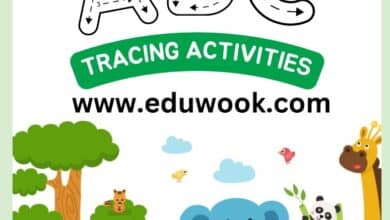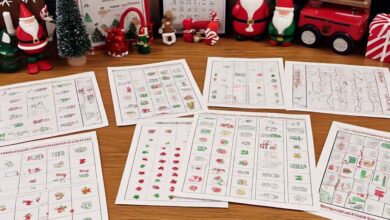The Ultimate Guide: Top 10 Must-Try Activities for Early Childhood Education and Development
Early childhood education lays the foundation for lifelong learning and development. Engaging activities designed for preschoolers not only support academic growth but also enhance cognitive, social, and motor skills. This comprehensive guide explores the top 10 must-try activities for early learners, ensuring a mix of fun, creativity, and skill-building. We believe that every child deserves a strong start in life, which is why we’re dedicated to providing high-quality educational resources for toddlers, preschoolers, and kindergarteners.

Locks in Letter set Exercises to Construct Early Literacy Skills
Teaching the letter set is a foundation of early childhood instruction. Exercises like letter set forager chases, letter-matching diversions, and tactile canisters filled with letter shapes can make learning fun and intuitively. Join singing letter set melodies or following letters in sand or shaving cream to lock in numerous faculties. These exercises offer assistance preschoolers recognize letters, relate sounds, and create a cherish for reading.
Additionally, consider presenting attractive letters for word-building recreations on a fridge or whiteboard. Consolidating narrating with letter set books advance reinforces proficiency associations and keeps children spurred.
UPPERCASE LETTER ACTIVITIES TO BUILD EARLY LITERACY SKILLS
Capitalized letters are frequently the to begin with sort of letters presented to preschoolers due to their effortlessness and uniformity. Activities such as creating uppercase letter flashcards, using playdough to mold letters, or engaging in “uppercase letter stamping” help children familiarize themselves with their shapes. Singing songs like “The ABCs” and emphasizing uppercase letters reinforces recognition.
Using everyday objects, such as arranging sticks or straws to form uppercase letters, adds a tactile element to learning. Games like “Spot the Uppercase Letter” in books or on signs make recognition practice enjoyable.
lowercase letter activities to enhance phonetic awareness
Lowercase letters are equally important for reading and writing fluency. Incorporate tracing worksheets that combine uppercase and lowercase letters for comparison. Encourage children to find lowercase letters in storybooks or during scavenger hunts.
Activities like “writing in the air” with their fingers or tracing lowercase letters in sensory trays filled with rice or sand promote fine motor skills. Focusing on phonics alongside lowercase letters helps children associate sounds with symbols, improving reading readiness.
Creative Ways to Teach Numbers with Preschool Worksheets
Number recognition and counting are vital early math skills. Use number worksheets featuring colorful illustrations to make learning engaging. Try activities like counting objects, matching numbers to quantities, and simple addition with visual aids. Worksheets can also include number tracing to reinforce fine motor skills while teaching numerical concepts.
Interactive activities such as creating “number bracelets” with beads or using household items like buttons or pasta for counting practice add a tactile element to learning. Games like “number bingo” or hopscotch with numbers make math both active and enjoyable.
Odd Numbers and Even Numbers: Early Math Foundations
Understanding odd and even numbers lays the groundwork for advanced math concepts. Start by introducing the concept using visual aids, such as grouping objects into pairs. For even numbers, show that every object has a partner, while odd numbers leave one object unpaired.
Use games like “Even or Odd Toss,” where children sort cards or objects based on their number type. Incorporating songs or chants about odd and even numbers makes learning memorable. Worksheets that highlight patterns in number sequences further solidify understanding.
Shape Sorting and Matching Activities to Boost Cognitive Skills
Shapes help children understand spatial relationships and lay the groundwork for geometry. Shape-sorting games, matching activities, and puzzles are excellent tools for teaching shapes. Printable shape worksheets and hands-on creates like making shape collages or sorting pieces into shape categories empower acknowledgment and categorization..
Awareness of shapes such as circles, squares, triangles, and straight lines is significant for understanding the world. Circles can be found in regular objects like wheels or clocks, whereas squares are seen in windows and tiles. Educating preschoolers to recognize and portray shapes makes strides visual-spatial aptitudes and vocabulary.
Consider exercises like “shape treasure chases,” where children discover objects of particular shapes in their environment. Incorporating art projects like creating animals or scenes from shapes allows for creativity while reinforcing shape recognition.
Fun Math Activities and Ideas for Preschoolers
Introduce basic math concepts through playful activities like building towers to learn measurements, using beads for patterns, or playing simple board games that involve counting. Math worksheets with locks in subjects, such as creatures or seasons, can give extra hone in a organized however pleasant arrange. These exercises cultivate basic considering and problem-solving skills.
Simple Addition
Introduce youthful learners to the concept of expansion utilizing substantial visual helps like counters, pieces, or dots. For case, illustrate how including two ruddy pieces to three blue pieces comes about in a add up to of five pieces. You can make the movement more intelligently by weaving in stories: “In the event that you have two apples and your companion gives you one more, how numerous apples do you have presently?” This approach interfaces theoretical math concepts to recognizable, ordinary circumstances, making it both open and fun.
Simple Subtraction
Subtraction can be effectively taught by physically removing objects from a group. Start with a set, such as five blocks, and remove two, showing how three blocks remain. To make this lesson more playful and memorable, try activities like “subtraction bowling,” where knocked-down pins represent items being subtracted from the total. Such games foster an enjoyable environment for understanding subtraction, reinforcing the concept through active participation.
Introduction to Multiplication
While multiplication may seem complex for preschoolers, introducing the foundational concept through grouping can lay the groundwork for later learning. Use regular things, such as toy cars or colored pencils, to illustrate how two bunches of three things each make six in add up to. Keep the involvement straightforward and visual—this hands-on approach makes a difference children start to get a handle on the nuts and bolts of increase in an instinctive and age-appropriate way.
Introduction to Division
Division can be introduced gradually by using the concept of equal sharing. For example, give four cookies to two children and explain that each child gets two cookies, demonstrating the division of objects into equal parts. This gentle introduction to division helps preschoolers understand how items can be shared fairly, creating a foundation for more complex division concepts in the future.
Exciting Science Experiments That Spark Curiosity in Young Learners
Science tests fascinate preschoolers and instruct them approximately the world around them. Basic tests like blending preparing pop and vinegar to make a “spring of gushing lava” or watching plants develop from seeds present fundamental logical standards. Empower hands-on investigation and inquire open-ended questions to invigorate interest and basic thinking.
Water play activities, such as testing which objects sink or float, teach basic physics concepts. Nature walks where children collect leaves, rocks, or flowers for closer examination encourage observation and classification skills.
Tracing Worksheets to Develop Fine Motor Skills
Tracing activities are essential for developing hand-eye coordination and preparing for writing. Provide tracing worksheets with lines, shapes, letters, and numbers. Start with simple patterns and progress to more complex designs. Using a variety of tools like crayons, markers, and pencils keeps the activity engaging and builds confidence in preschoolers.
Incorporate sensory tracing by using sandpaper letters or gel-filled bags. These materials provide a unique texture that enhances the learning experience. Encourage repetition and celebrate progress to boost confidence.
Seasonal Fun: Fall Coloring Pages and Crafts for Preschoolers
Seasonal themes add excitement to learning. Fall coloring pages featuring leaves, pumpkins, and animals provide a creative outlet while reinforcing fine motor skills. Combine coloring with simple crafts like making leaf rubbings or creating paper pumpkins to celebrate the season. These activities enhance creativity and teach seasonal awareness.
Expand the fun by integrating storytelling into the activity. For example, read a book about fall and encourage children to draw their favorite scenes. Seasonal scavenger hunts, such as finding items in autumn colors, also promote exploration.
Educational Wooden Puzzles to Enhance Problem-Solving Abilities
Wooden perplexes are a immortal instrument for creating problem-solving and spatial thinking abilities. Begin with basic astounds highlighting fundamental shapes or creatures, at that point present more complex ones as children advance. Astounds progress concentration, persistence, and cognitive capacities, making them an important expansion to any preschool action lineup.
For included assortment, attempt themed perplexes such as transportation, creatures, or regular pictures. Energize cooperation by having children fathom astounds together, cultivating participation and communication skills.
Music and Movement Activities for Active Learning
Music and development exercises combine physical exercise with cognitive advancement. Singing activity melodies like “Head, Shoulders, Knees, and Toes” or playing melodic recreations like solidify move offer assistance preschoolers create coordination, beat, and memory. These exercises too advance social interaction and self-expression.
Incorporate rebellious like tambourines, maracas, or drums to include another layer of engagement. Empower children to make their claim tunes or rhythms to cultivate inventiveness and self-confidence.
Storytime and Pretend Play for Language and Social Development
Storytime is a effective device for building lexicon and comprehension. Perusing out loud empowers tuning in aptitudes and presents unused words. Combine this with imagine play, such as making a “eatery” or “doctor’s office,” to cultivate inventiveness and social abilities. These exercises offer assistance children get it parts, hone communication, and construct empathy.
Add assortment by utilizing manikins or ensembles to make stories come lively. Energize children to retell stories in their possess words, strengthening comprehension and boosting certainty in dialect use.
Art and Craft Activities for Self-Expression
Art exercises like portray, drawing, or chiseling with playdough permit children to express their inventiveness. These exercises progress fine engine abilities and give a sense of achievement. Energize open-ended ventures where children can investigate their creative energy freely.
Introduce topical makes, such as making occasion enhancements or nature-inspired craftsmanship, to tie in with other learning ranges. Showing their manifestations boosts self-esteem and includes a individual touch to their learning environment.
Outdoor Play for Physical and Social Development
Outdoor exercises like playing on a play area, riding tricycles, or locks in in bunch diversions advance physical wellness and social interaction. Nature-based exercises like planting blooms or investigating a plant educate duty and interest around the environment.
Incorporate challenges like impediment courses or forager chases to include fervor and cultivate collaboration. Open air play is basic for all encompassing advancement and makes a difference children interface with the characteristic world.
Incorporating these exercises into early childhood instruction guarantees a all encompassing approach to learning. From education and math to inventiveness and social aptitudes, each movement is carefully outlined to address distinctive perspectives of advancement. By locks in children with fun and significant assignments, guardians and teachers can lay a solid establishment for future victory whereas making learning an pleasant encounter.










